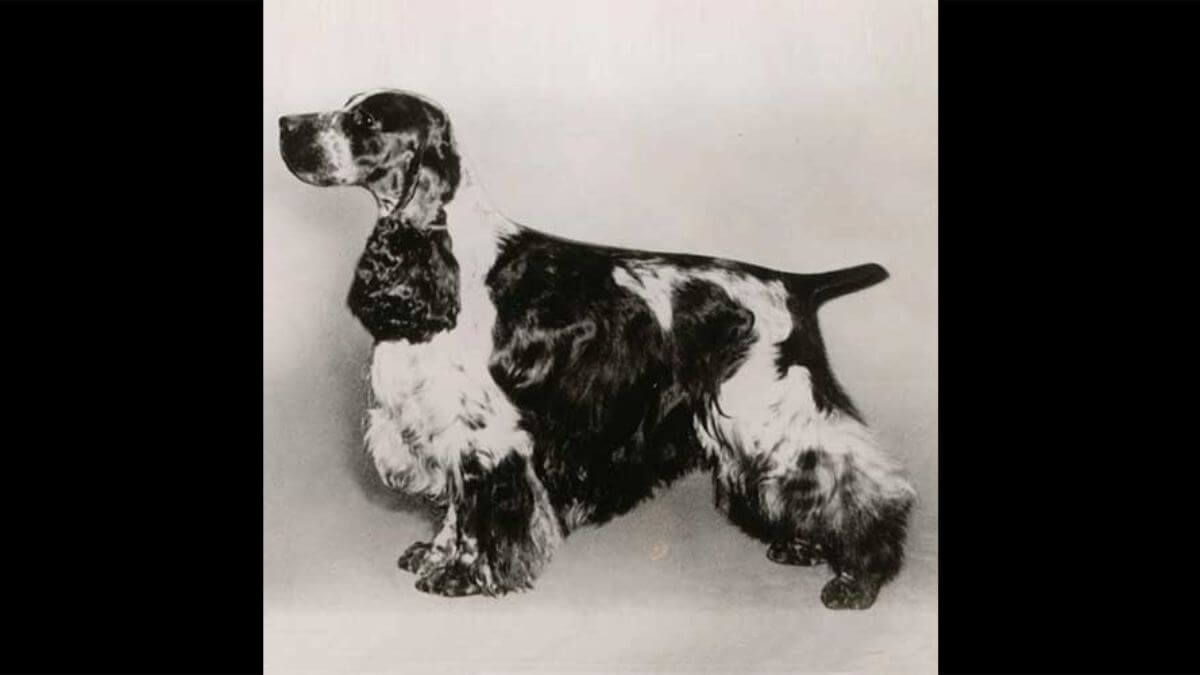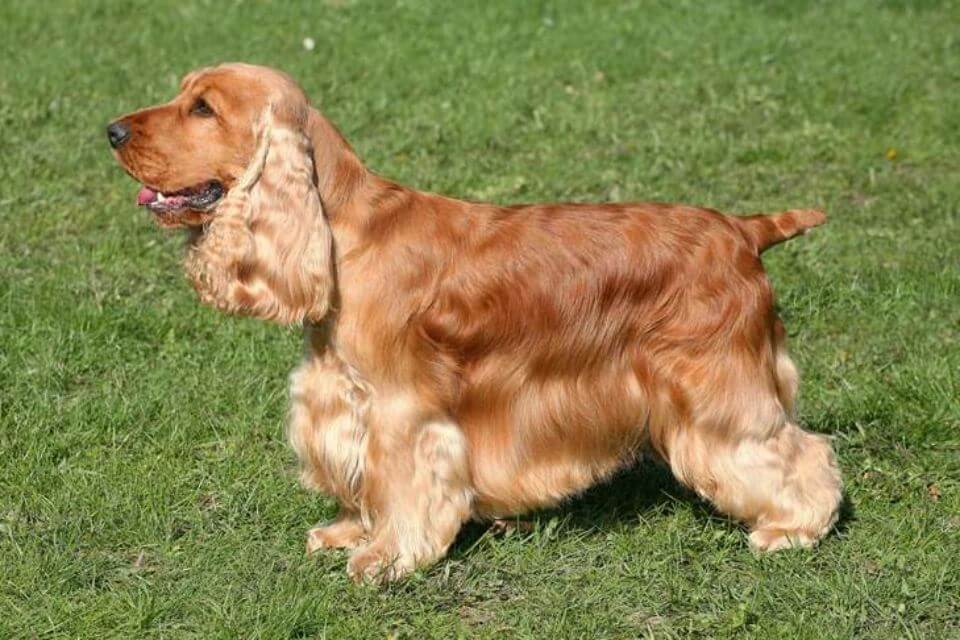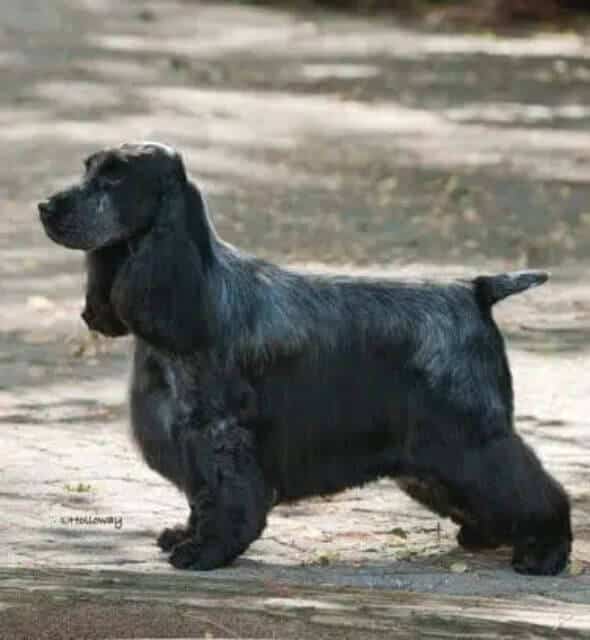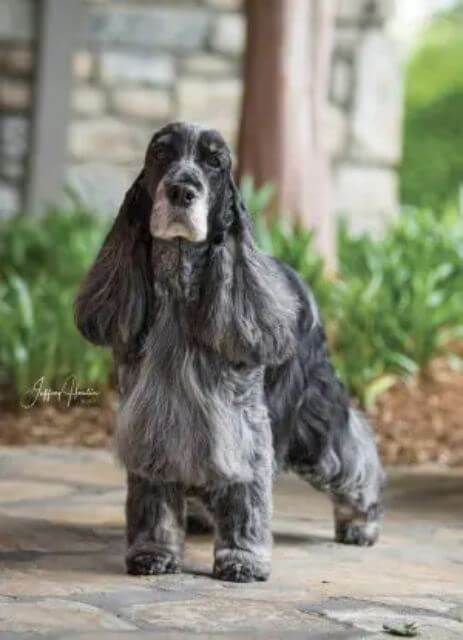
Home » Understanding the English Cocker Spaniel

This article was originally published in Showsight Magazine, June 2015 issue.
Tthe front is defined as: “the forepart of the body as viewed head-on or from the side, including forelegs, chest, brisket, and shoulder line.” We should be breeding for correct type and an overall balanced dog. However, without a basic understanding of correct structure (which is also part of correct type), we may end up with something pretty but not functional. While structure is fundamental dog knowledge, fronts are the hardest to understand. The front is possibly the most important part of a four-legged mammal, including dogs. To understand why the front is so crucial, we need to consider some important facts.
Like all parts of the skeletal system, it serves as scaffolding upon which everything hangs. It provides locomotion and protects vital internal organs. Each of these aspects is critically important, especially for our smallest gun dogs, who need to be stronger for their size than any other gun dog. The front bears more weight than the back half of the dog, especially when the dog is carrying game, prey, or other objects, so it must be strong.
During movement, the dog is essentially falling forward and downward onto its front after propulsion from the rear, with the front also aiding in propulsion. Because the dog falls forward with each stride, the front must be strong enough to catch the weight while also being well-cushioned for impact. Since the front houses the heart and lungs of a hardworking and athletic hunting animal, there must be adequate space within the ribcage to accommodate well-developed organs. The Cocker needs to take fewer, more efficient steps, allowing it to travel farther with less effort and do more work in a day.

FORM FOLLOWS FUNCTION
On an English Cocker, a good front is not just a pretty-coated, well-feathered piece with withers slightly higher than the rear, only ever viewed from the side. The Cocker must push through heavy cover while carrying game larger for its size than any other sporting dog. Historically, it has been used for pheasant and other game birds, as well as hare.
There is a reason our beautiful breed’s front needs to match the standard. The standard states: “The English Cocker is a solidly built dog with as much bone and substance as is possible without becoming cloddy or coarse.” Bone needs to be significantly strong to carry heavy muscle. The muscle is more typical of a weight lifter, capable of pushing through dense cover and carrying heavy game, as opposed to the type of muscling found on a gun dog that runs over large, open fields.
The amount of trappy terrain a dog needs to navigate is in proportion to the amount of bone and muscle a breed requires. In human form, think of a runner’s build versus a weight lifter’s. This is why we say the Cocker is rounded and contoured and is not made of angular planes with long, flat muscle types.
The standard states: “His gait is characterized more by drive and the appearance of power than by great speed. He covers ground effortlessly and with extension both in front and in rear, appropriate to his angulation.”
To carry the dog, his front needs to move efficiently. We want strength and endurance, not speed. The ideal, efficient stride allows the front foot to reach forward to a line dropped vertically underneath the nose, landing just behind the nose to push off when it is underneath the dog. This enables the dog to take fewer, more efficient steps, allowing him to work for longer periods.
The standard calls for a dog’s withers to be well laid back, and the upper arm should return or lay back the same distance and at the same degree as the scapula. The ideal angulation is for the front to form a 90 to 100 degree angle, with the highest point of the shoulder (withers) directly above the elbow, which is also directly above the back of the front foot when properly stationed. The reason for this is mechanical advantage: the front legs can reach forward in a projected line that follows the degree of layback of the scapula.
The upper arm needs to be the same length as the shoulder. An upper arm of equal length, coupled with the length and layback of the shoulder, makes for optimal stride length and propulsion.
The bottom left photo shows our Cocker’s standing outline with an image of balanced movement over it. Note the 45-degree angled lines over the front and rear legs. This illustrates equal reach and drive. To allow freedom in front and correct front reach, the head drops to about a 45-degree angle.
In the show ring, when a Cocker is “strung up” with the lead held vertical and taut, the head stays in a more upright position, preventing the Cocker from demonstrating correct, sporting dog movement.
A dog with an inadequate front cannot reach to its nose. It is completely wrong for a gundog to be short-strided in front. If the scapula is more upright, the upper arm and foreleg cannot reach to the vertical line dropped from the dog’s nose, resulting in a shorter stride. Additionally, a dog with a shorter foreleg cannot achieve sufficient stride length or ideal leverage to propel itself forward. A dog with a more upright foreleg also lacks the ability for an ideal range of motion and tends to have a more upright pastern as well. Any of these faults cause the dog to take more steps during an hour, a day, or its lifetime.
The dog does not need to reach past the nose. Anything beyond the described ideal creates wasted motion and wasted energy.
While flashy and eye-catching, this type of movement is atypical of a correct Cocker and is of no use in the conditions under which the breed works in the field. It should no more be rewarded in the ring or incorporated in a breeding program, any other movement fault that inhibits the Cocker from functioning correctly can be detrimental. Here is a dog that is unable to extend its front to its nose, yet is kicking way too far behind with the rear. This compensation is caused by a straight front, characterized by an upright scapula and a short upper arm, combined with an over-angulated rear.
Additionally, a dog with ideal angulation has more area for muscling. Imagine a 90-degree triangle compared to one with shallower angles. You can see that the latter leaves less space for carrying a well-developed musculature.

In this case, the shoulder is tipped forward instead of being laid back towards the rear of the dog. This placement puts the withers well forward of the elbow. When in motion, the dog will look as if it is falling over its front, which is exactly how it is made to move. Due to the incorrect placement of the scapula, the neck juts forward and is very restricted in its range of motion, a true detriment in the field.
The standard states that the chest should be deep, not so wide as to interfere with the action of the forelegs, nor so narrow as to allow the front to appear narrow or pinched. The dog must have good spring of rib to house heart and lungs of sufficient capacity. The rib should extend downward to at least the dog’s elbow. A shallower ribcage crimps space for heart and lung expansion.
From the front, the rib should be heart-shaped at its widest point. If one were to take sliced transverse images from the elbow forward, the shape is significantly narrower than a slice taken from its widest part farther back. This is because, as the dog reaches forward, the legs should begin to converge. This aids in smooth, more forward movement.
Think of yourself when you try to run. As you move faster, if you make an effort to keep your legs as wide apart as they are when standing, it causes a stilted, side-to-side movement, which is not conducive to good running. The same principle applies to a sporting dog!
Consider that a Cocker is a smaller, wider breed than other sporting dogs. If its width is sufficient, its front legs will never converge on the same line (single tracking) or even come close to it. This is because it is a wider breed with more muscle for its size than other, taller dogs.
Regarding pasterns, the standard states that they should be nearly straight with some flexibility. The pastern needs enough angulation to give upon landing. An absolutely upright pastern will act more like a post, with no natural give. Conversely, a pastern with too much bend will lack strength and may cause strain to ligaments and tendons.
Compare the greater slope of the front pastern with that of the rear. The front pastern must deal with more concussive forces and needs to be more shock-absorbing.
In the words of Anne Rogers Clark, a second-generation English Cocker breeder and ECSCA Past President, “In any breed, the whole dog is hung on its front end. How the neck is set and how its topline is all go to the front. There must be a forechest out in front.”
She further notes, “We’re getting a lot of English Cockers whose fronts drop straight down, a so-called Terrier front, where they’re laid back in the shoulder, short in forearm, and their fronts are way out in front of them with no forechest. It’s totally incorrect for a Cocker. You’ve got to have some forechest!
